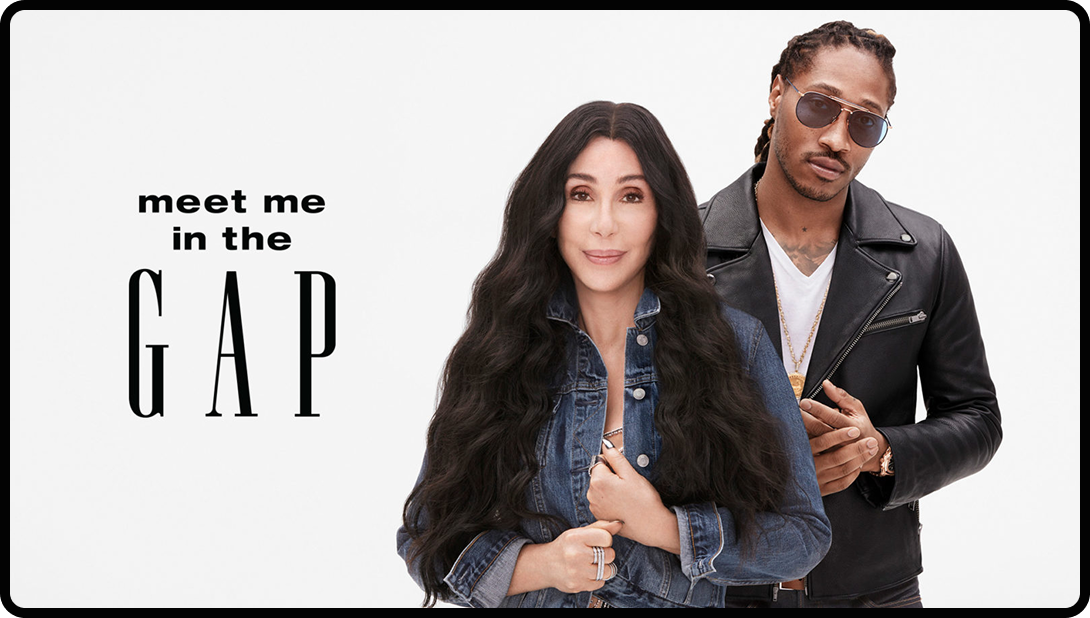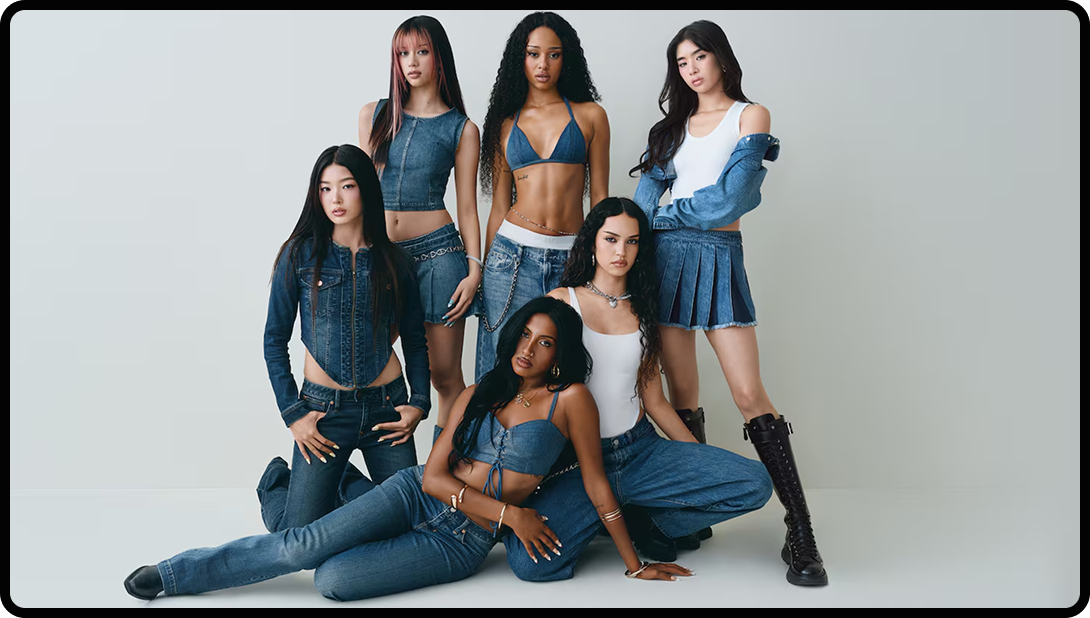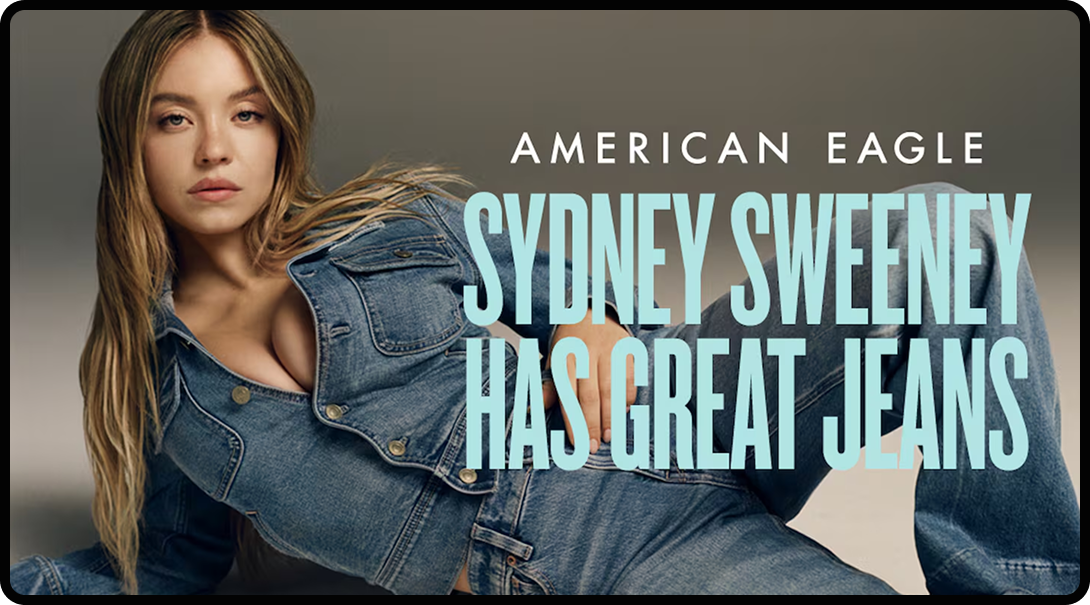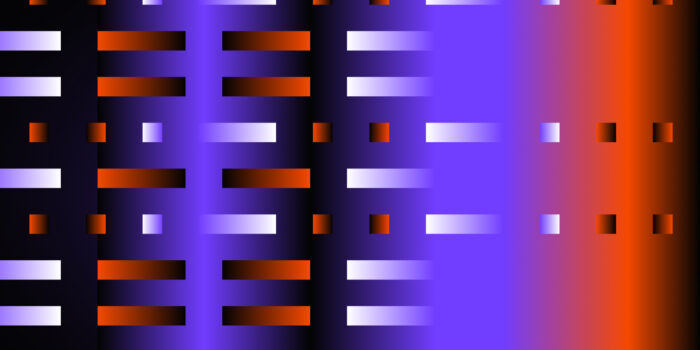From khakis to red carpet couture, Gap has totally reinvented itself; and people have taken notice.
Known for its modern and casual apparel, Gap has been selling its products since 1969. Their popularity began when fashion culture started shifting towards casual wear in the 80s and 90s. Under CEO Mickey Drexler, Gap marketed itself as a casual, cool company focusing on accessible and comfortable wear sold at affordable prices. In just five years, they accumulated $15 million in annual sales and over 25 stores, becoming a cultural phenomenon.
Around the late 90s and early 2000s, Gap’s sales started to decline. They were fighting irrelevancy. They tried their best to stay top of mind for consumers, but times were changing, and their styles weren’t catching up to what their audience wanted.
Their production was slower than cheaper and faster brands like Zara and H&M, and the business was severely underperforming in comparison to their competitors, American Eagle and Abercrombie & Fitch. At the same time, malls were losing popularity due to the rise of online shopping, so Gap was experiencing a decline in foot traffic as well. Overall, the company was failing because they couldn’t adapt to change.
Gap’s Comeback Playbook
Gap’s comeback wasn’t easy; it was a multi-year effort with the goal of bringing back their brand relevance. With multiple failed attempts over the mid 2010s, it wasn’t until late 2023 that Gap finally regained its popularity.
How did they do it? They changed their entire marketing strategy: from their hires, to their website, socials, campaigns, and most importantly, their celebrity partnerships.

Injecting New Faces & Ideas
The rise in sales began with the appointment of Richard Dickson as the new CEO in 2023. Dickson was originally Gap Inc.’s Board Director in 2022, as he was working at Mattel as the President and COO. He led design and development, brand marketing, innovation strategy, and more during his time at Mattel, and was credited for the revival of Barbie.
During the first few months in his new position, Dickson focused on Gap’s purpose, product innovation, cultural relevance, and execution. One of his most impactful moves included hiring Zac Posen, who essentially changed the game for Gap.
Zac Posen is an award-winning creator who is known for his excellent technique and inclusive designs. He’s worked with many well-known brands, including Target, David’s Bridal, and Project Runway. In February 2024, he was named EVP & Creative Director of Gap Inc. and was to focus on leading design, merchandising, and marketing. Posen made a huge impact in his broader efforts to reignite the new culture of creativity.
In April 2025, he released an elevated collection (a break from Gap’s modern but basic style), that included over 50 pieces. Later in May, he designed an all-denim Met Gala gown for actress Da’Vine Joy Randolph, inspired by Gap’s heritage denim, which sparked even more public interest in GapStudio.
Gap also partnered with Omnicom Media Group in 2024, aiming to help achieve the brand’s vision to become a high-performing, iconic American brand. The group provides different strategies, talent, and partners, using their expertise in the speed of culture to help Gap stay up-to-date and sustain their relevance, which was one of the biggest reasons for their downfall in the 2000s. This partnership also allowed Gap to leverage OMG’s experience with major consumer brands like Apple, Disney, and L’Oreal.
Redesigning Their Websites & Socials
To keep up with the rise of social media, Gap incorporated its updated look into the brands they acquired. The (somewhat boring) early 2000s and 2010s Gap was no more; rather, they elevated their products using a heritage-led strategy that was to serve nostalgia, combined with updated marketing and exciting collaborations. Essentially, they developed a modern social presence that doesn’t take away from their nostalgic value.
On their website, they focused on better photography, capturing eye-catching angles with cleaner formatting. Even when keeping aesthetics in mind, their website retained Gap’s brand essence, using simple fonts and a consistent color scheme. They also added video lookbooks of their products on the website, making it easier for consumers to see all angles.
As Gen Z and Millennials became the setters and adopters of fashion trends, 90s nostalgic looks were coming back (hello Y2K), and Gap took that opportunity to come in, guns blazing.
They became more active with their social media marketing, featuring user-generated content and interactive posts, boosting engagement and brand visibility. They also started working with influencers, using the rise of TikTok and influencer culture to start the buzz around their products. In addition to traditional influencer marketing, Gap interacted and collaborated with regular social media users.
One of their greatest successes with this marketing strategy is their partnership with TikTok creator and social media influencer Julia Huynh, known for her lifestyle and travel content. She co-designed a hoodie with Gap after she expressed frustration with clothes shopping in a video about finding “the perfect hoodie that hoodies.” Gap jumped on the opportunity to work with her and invited her to co-create a hoodie with their design team in New York. Understanding the cultural shift of influencer marketing, Gap made sure to stay on top of this through this collaboration.
Learning From Their Mistakes
Here’s the kicker with all of these changes: this wasn’t Gap’s first time trying to rebrand itself. They had made another attempt to come back from the dead in 2010, which sparked public backlash, mainly due to their redesigned logo (that’s right, Cracker Barrel didn’t do it first). This disastrous move negatively impacted their brand perception and value, causing consumers to protest; the announcement actually generated 2,000 negative comments in just 24 hours.

What’s the lesson to learn here? The importance of branding and brand equity, especially when it comes to listening to (and understanding) your customers’ likes and dislikes. Gap’s brand is all about nostalgia, and by “modernizing” their logo, they went directly against their own essence. Customer loyalty and trust? Gone. When your audience has a deep, emotional connection to your aesthetic and identity, and you strip that identity away, you’re turning your customers away, too.
Launching New Marketing Campaigns & Initiatives
What people resonate with and gravitate to when it comes to marketing is a message with meaning behind it. Gap was able to encompass that by spinning up campaigns focused on things they knew their audience cared about: sustainability, inclusivity, and individuality.
A Push for Sustainability
Sustainability has been part of the purchasing conversation for the better part of a decade, and it’s increasingly becoming a top-of-mind concern for consumers. Purchasing sustainable goods is seen as a form of activism: influencing corporate behavior for the betterment of the planet.
By using sustainable cotton and Washwell techniques, Gap pushes its initiative for a sustainable and equitable future in “Gap for Good.” They partnered with organizations like the Ellen MacArthur Foundation, whose mission is to accelerate the transition to a circular economy.
The Result: When consumers see the impact that a company is making for the greater good, they’re influenced to buy their products, which exponentially spreads word-of-mouth and organic media buzz.
The Inclusivity Angle
For Gen Z and Millennial audiences, brand loyalty often stems from a sense of safety and inclusion, which is why inclusivity is such an important aspect to brands looking to succeed in today’s markets. Inclusive marketing makes customers feel valued and boosts their self-esteem, and that’s exactly what Gap’s “Meet Me In the Gap” campaign was centered around.
This multi-media campaign focused on unity, inclusion, and diversity, which was displayed through the pairing of unlikely features such as Cher and Future, demonstrating different individuals connecting and finding things in common. Each collaboration was intentionally unscripted to see what could be the result of the unexpected.
The Impact: When consumers see a brand turn diversity into a priority, they’re more drawn to the company’s values, broadening the audience that feels they can be a part of the culture.

Long Live Individuality
Everyone has a different sense of style. Clothing is a way of expression and individuality, which is exactly what Gap honed in on.
Gap’s 2017 campaign “Bridging the Gap” featured a diverse cast, including celebrities, artists, and models like Priyanka Chopra and Wiz Khalifa. In this social media-focused campaign, participants were shown customizing white Gap T-shirts in ways that represented their authentic selves. The purpose of the campaign was to showcase the simplicity of a plain white T-shirt, embodied differently by unique individuals. They were sure to cast people in a variety of different shapes and sizes to celebrate diversity, but bringing them together by using the same color shirt to celebrate unity.
So why were these all successful? These campaigns and initiatives spoke to consumers in a way that was relatable, aligning themselves not just with their own values, but the values that Gap’s customers hold. Sustainability, inclusivity, and individuality are all elements that are important in this new wave of culture within marketing, and brands that are able to successfully market themselves through these values reach a wider range of audiences.
Celebrity Branding: How the Face Can Make or Break Your Campaign

Celebrity brand partnerships aren’t revolutionary as a concept; brands have been using these types of promotions as marketing tactics since the 19th century. The drive behind celebrity partnerships is to leverage credibility to consumers: when we see a well-known face in an ad, we automatically gravitate towards it, often without first recognizing that it’s branded at all. Celebrity faces help customers remember the product, keeping the brand at the forefront of their mind (even if it’s subconscious), increasing sales and brand awareness.
Gap’s celebrity advertisements stick to a specific formula, displaying their cast in visually appealing and color-coded clothing, singing or dancing, in a simple and clean set design. Some of their notable advertisements include Tyla x Jungle, Troye Sivan, and (the latest one to make a huge splash online) KATSEYE. There’s a few reasons these advertisements resonated with the audience so well: timing, concept, and cast choice.
Tyla x Jungle x Gap
In 2024, there was a lot of public noise around Tyla; after all, she was fresh off of a Grammy win. Gap was quick to action, partnering with Tyla in combination with British group Jungle, creating an ad showing them perform intricate choreography. This was more art piece than ad, while at the same time displaying Gap’s linen products’ flexibility, comfort, and quality.
Combining authentic collaboration, current trends, and visual satisfaction, this campaign was highly successful.
Troye Sivan x Gap
In order to connect with their Gen Z target audience, Gap collaborated with a popular singer (and former YouTuber), Troye Sivan. Sivan was the perfect celebrity partnership selection based on his shared values with Gap; things like self-expression, individuality, and creativity. And so became their “Get Loose” campaign, released as an expressive dance advertisement that brought feelings of nostalgia.
This advertisement made more than waves; it nearly tripled Gap’s video views record on Instagram and became Gap’s most-liked video on both Instagram and TikTok.
KATSEYE x Gap
Okay, I know you’re dying to talk about Gap’s most recent and most popular collaboration: KATSEYE. KATSEYE is a musical girl group that broke the standards set by traditional K-Pop collectives. Since their formation, they have become a global sensation, finding success through their catchy music, Netflix documentary, and high-profile backing of HYBE and Geffen.
They might be known for their Y2K-influenced fashion, but they are adored for their authentic and diverse personalities; the members come from a wide variety of backgrounds, and wear their cultures proudly. For Gap, collaborating with KATSEYE was an incredibly smart marketing strategy as due to the clear value alignment between the two brands.

A particular part of the success of the KATSEYE collaboration was also due to timing. Gap’s campaign with the girl group was released during a period of corporate uproar over Sydney Sweeney’s American Eagle campaign that was taglined “Sydney Sweeney has great jeans.”
The public took issue with not only the tagline, but the script of the video ad and the campaign’s underlying message, which echoed as eugenics rhetoric based on Sweeney’s blonde hair and blue eyes. People felt as though the ad was promoting harmful ideologies and supporting the “traditional” feminine ideal.
American Eagle did not issue an apology for the campaign; rather, their official statement reinforced that the campaign was about jeans, with no underlying messages.
The American Eagle and Gap ads are a strong case study for one thing: the face of the advertisement is just as important as the ad’s message. In their campaign with KATSEYE, Gap was able to emphasize the value of their brand by promoting individuality, cultural diversity, and inclusivity, while continuing to produce creative and aesthetically pleasing ads. American Eagle, however, had a similar concept with an opposite effect; and customers responded accordingly.
The Outcomes of Reinventing Your Brand
Gap has proven that reinventing your brand can have a positive outcome, so long as you understand your customers, create a timely marketing strategy, and maintain cultural relevance while spreading your brand’s mission and values. Their comeback was a prolonged process and wasn’t easy to do.
Through new hires, updated web and social media pages, creative campaigns, and diverse celebrity ads, Gap found a way to the people’s hearts, wants, and needs. They were able to increase their influencer mentions by 73% in 2023 and 2024, also achieving a sales increase of 1% during fiscal year 2023. Gap also beat Wall Street’s earnings expectations in 2025.
If all goes to plan, Gap will continue to maintain (or even increase) its sales through these marketing strategies; ones that many other companies could learn from now and in the future.







